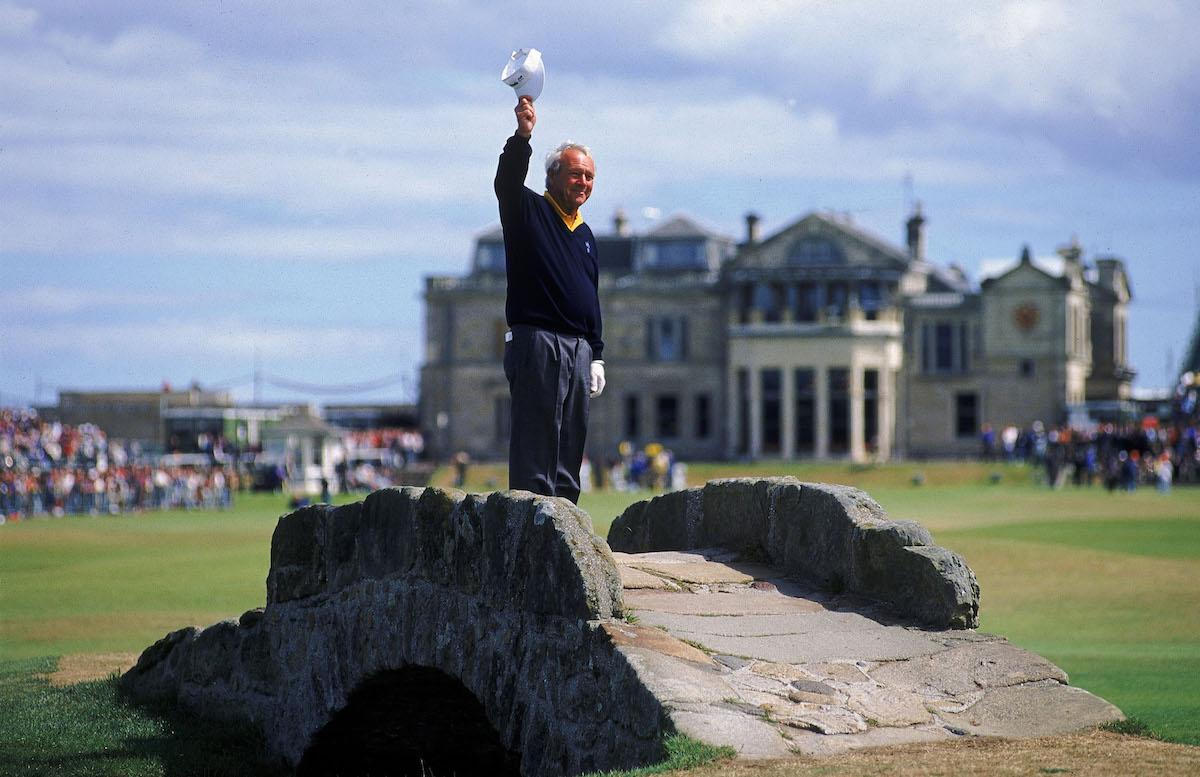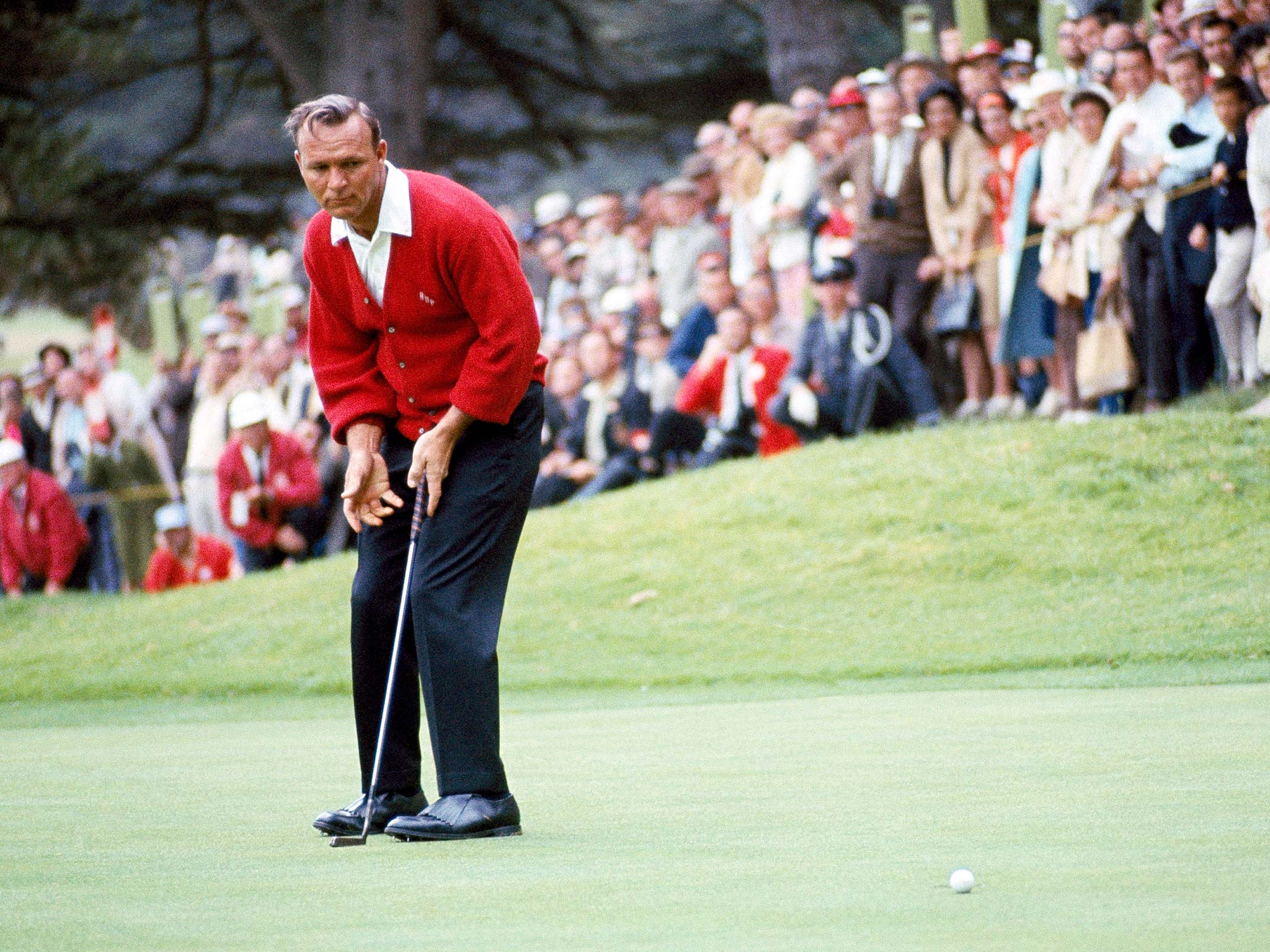Arnold Palmer obituary: The King of golf, who took the game to the masses
Palmer’s individuality was evident in all he did, from hitching his trousers as he stalked a difficult putt to a trademark high finish to his drives

Arnold Palmer proved to be one of the most influential figures in the history of modern golf. As his great rival and friend Jack Nicklaus put it, Palmer “took golf from being a game for the few to a sport of the masses”.
Owing to a combination of factors, he proved the right man at the right time. Palmer’s emergence on the sporting scene in the 1950s coincided with the emergence of television and air travel, and his dramatic achievements on the course drew many newcomers to the game. His fans, who nicknamed him “The King”, were vociferous in support of their hero, and were themselves known as “Arnie’s Army”, as they followed him enthusiastically down the fairways of the world. At his peak, Palmer was the leading player of his day, spanning the eras of Ben Hogan and Jack Nicklaus.
His significance was not confined to America. By appearing in the Open Championship in Great Britain from 1960, and encouraging his compatriots to do likewise, Palmer restored an event then neglected by many leading Americans to a pre-eminent place among the great championships that it has never lost. Not only was the expense and time involved a disincentive to American golfers (Sam Snead, the winner in 1946 at St Andrews, lost out financially by appearing), but the totally different conditions of links golf proved a puzzling and alien challenge.
Palmer thrived on such challenges and formed what was to be a celebrated partnership with the legendary Scottish caddy James ‘Tip’ Anderson, drawing on Anderson’s intimate knowledge of British links golf as an essential part of his campaigns. Palmer’s performance in successfully defending his Open title at Troon in 1962 on a hard, sun-baked course, Anderson at his side, was a master class in golfing strategy that proved one of his finest hours. On a course that was nigh unplayable for many of the field, Palmer set the then lowest aggregate (276) for the championship.
Palmer was a pioneer in other ways. By signing up in 1959 as the first client of Mark McCormack, a shrewd Cleveland lawyer, Palmer revolutionized the whole concept of sporting economics through endorsements and sponsorship. McCormack, in tune with the latest business methods, swiftly identified Palmer’s special marketability: his handsome bearing, his relatively modest beginnings; his risk-taking, emotional style on the course; the many dramatic finishes in which he was involved, but above all his charisma and affability. The Palmer-McCormack duopoly was the financial making not only of them, but of generations of future sporting stars, especially in tennis.
Palmer was the senior figure in what became known, through McCormack’s marketing, with Jack Nicklaus and Gray Player as ‘The Big Three’, whose classic sporting battles defined golf in the public image in the 1960s. Not surprisingly, Palmer was the first golfer to fly his own plane to tournaments, the first to win the US Masters four times and the first to win one million dollars in career earnings. He was a personal friend, and golfing partner, of President Eisenhower, and was invited to address Congress in 1990 on the cenetenary of Eisenhower’s birth. In 1976 Palmer established a speed record for flying round the world in a twin-engined jet. He was, in short, the American dream writ large.

Arnold Palmer was born on September 10 1929 in Youngstown, Pennsylvania, son of Milfred ‘Deacon’ Palmer and Doris Palmer. The family home bordered the then small nine hole Latrobe Country Club, where Palmer was taught the rudiments of the game by his father, who was the green keeper and later professional. Later Arnold Palmer was to be owner and President of the vastly expanded facility. His aptitude for the game was apparent from an early age (he broke 100 at the age of seven) and he attended Wake Forest University on a golf scholarship. Enlisting in the Coast Guard, he was able to spend time building up his golfing skills. In 1954 he won the US Amateur Championship, a victory which persuaded him to try the professional circuit. In December that year he married Winifred Walzer. Theirs was one of the most enduring and happy of marriages. They had two daughters. After his first wife’s death in 1999, he later married Kathleen Gawthrop in 2005.
Palmer’s first PGA Tour victory came in the prestigious Canadian Open in 1955, when he posted his lowest ever four-round total with scores of 64, 67, 64 and 70. Overall he was to win 92 tournaments worldwide, 61 of them on the PGA Tour in America. He won seven major championships. In addition to his four Masters titles, he won the US Open at Cherry Hills in 1960, with a final round of 65, and the Open in 1961 at Birkdale and 1962 at Troon.
The manner of his victories brought him vast popularity. At Birkdale in 1961 he overcame tempestuous conditions that blew away marquees and washed out Friday’s play. His first six holes of his second round in 3-under par in the worst of the weather was a unique form of golfing brilliance. But even that was surpassed by arguably the most famous shot he ever played. At a crucial moment in the delayed final round his drive ended deep in thick willow shrub on the 15th (now the 16th) hole.
Palmer once said that his epitaph should “he always went for the green” and although on occasions the tactic proved hazardous, this time it paid off handsomely. Taking a six iron, he uprooted the ball and what his fellow golfer Dave Marr described as “Caesar’s salad for 10”, cleared 150 yards of impenetrable rough and ended 15ft from the pin to save his par. Palmer won the title by a single shot.
A plaque marks the spot today from where Palmer played his iron. Another plaque on the first tee of Cherry Hills records that he drove the 346-yard par four on his way to a final round of 65 which won him his 1960 US Open Title from seven shots back. The one major title that eluded Palmer was the US PGA, although he was runner up in 1964 and 1968.
With McCormack, Palmer was instrumental in establishing up the annual autumn World Match Play Championship at Wentworth in Surrey, winning the inaugural tournament in 1964, as well as in 1967. He won the Canada Cup on three occasions, twice partnering Sam Snead, and once Jack Nicklaus; and the Vardon Trophy for lowest scoring average four times. He played on six Ryder Cup Teams, in 1963 as the last playing-captain, and he captained the team again in 1975. His last victory on the PGA Tour was the 1975 Bob Hope Desert Classic. He was inducted into the World Golf Hall of Fame in 1974.
Palmer’s individuality was evident in all he did, from hitching his trousers as he stalked a difficult putt to the trademark high finish to his drives. His swing was never the smooth robotic piece of golfing manuals, but a vigorous, almost ungainly, assertion of power and will that thrilled the crowds.
His long game had an enviable consistency. His tally of major championships is not a fair reflection of his dominance. A few putts here and there, and a more conservative approach at times of crisis – he came second in 10 majors – could have seen him win twice as many. But as he said, ‘Winning isn’t everything, but wanting it is.’
Palmer was eligible for the Senior PGA Tour (now the Champions Tour) from its first season in 1980 and his participation ensured the success of what proved an immensely popular new departure, not merely an exercise in nostalgia. He won 10 times on this senior tour, including, poignantly, his very first tournament, the Senior Championship version of the PGA in 1980, and four other senior majors, including the Senior US Open in 1981. In 2004 Palmer competed in the Masters for the last time, his 50th consecutive appearance. He retired from tournament golf in October 2006.
Palmer’s influence did not end with his playing days. He had a diverse business career, and remained one of the highest earners in world sport. He owned the Bay Hill Club, the annual venue of the PGA Tour’s Arnold Palmer Invitational (formerly the Bay Hill Invitational); he helped to found the televison Golf Channel. He also designed many courses through his company, Palmer Course Design (1972), later Arnold Palmer Design Company (2006), notably PGA West in California, and the first course in the People’s Republic of China.
Arnold Palmer stands four-square in the select line of golfing greats from Old Tom Morris to Tiger Woods, a model example in all he did, and, whether playing with presidents or club members, one of the most modest and likeable.
Arnold Daniel Palmer, professional golfer, born Youngstown, Pennsylvania, 10 September 1929; married, firstly, 1954 Winifred Walzer (died 1999), two daughters; secondly, Kathleen Gawthrop, 2005; died, Pittsburgh, Pennsylvania, 25 September 2016
Join our commenting forum
Join thought-provoking conversations, follow other Independent readers and see their replies
Comments